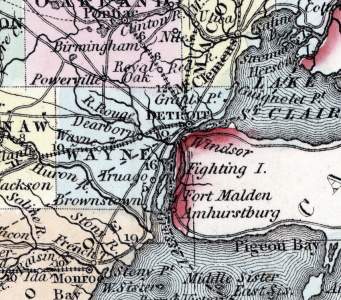Detroit, Michigan (Fanning's, 1853)
Gazetteer/Almanac
DETROIT, city, and seat of justice of Wayne co., Mich., occupies a pleasant and commanding situation on the west bank of Detroit river, 18 miles from Lake Erie, and 7 miles from Lake St. Clair. Between the two great lakes, Huron and Erie, upon both of which, its vessels carry on an extensive trade, through Lakes Superior and Michigan, and with Canada, Pennsylvania, and New York. It is an important metropolis of the western states, and is destined to a still higher rank than it now holds. The city is agreeably laid out with broad streets, some of which converge at the “Circus,” a spacious public ground. Among the other parks, is the “Campus Martius,” near the centre of the city. Parallel with the river, at the foot of the imminence upon which the town is built, is a street lined with warehouses and stores. Above this, another street rune in the same direction, and still further to the west, is the principal business street, which is closely built with stores, dwellings, and public buildings. Here, until 1847, when the seat of government was removed to Lansing, stood the statehouse, from the high dome of which appears an enchanting prospect of the river, Lake St. Clair, and their picturesque and romantic shores. Other buildings are the city hall, bank of Michigan, churches, markets, schools, and various scientific and literary institutions. Several hundred steamboats and other vessels, from various places on the lakes, visit Detroit during the season of navigation, which lasts about two thirds of the year.
The Michigan Central railroad extends 281 miles toward Chicago, on Lake Michigan; and the Detroit and Pontiac railroad is 25 miles long.
The population in 1810 was 770; in 1820, 1,422; in 1830, 2,222; in 1840, 9,102; in 1850, 21,119.
The Michigan Central railroad extends 281 miles toward Chicago, on Lake Michigan; and the Detroit and Pontiac railroad is 25 miles long.
The population in 1810 was 770; in 1820, 1,422; in 1830, 2,222; in 1840, 9,102; in 1850, 21,119.
Fanning's Illustrated Gazetteer of the United States.... (New York: Phelps, Fanning & Co., 1853), 105.







